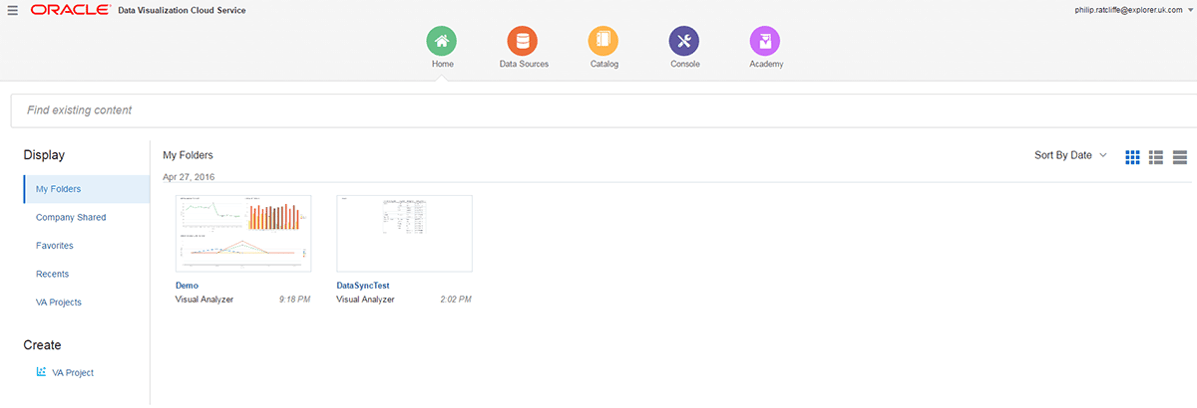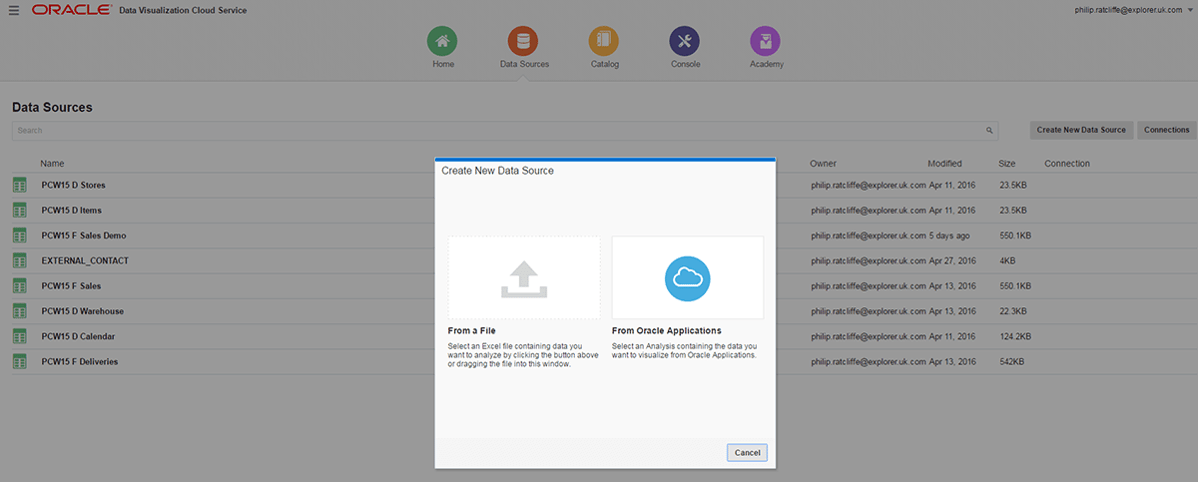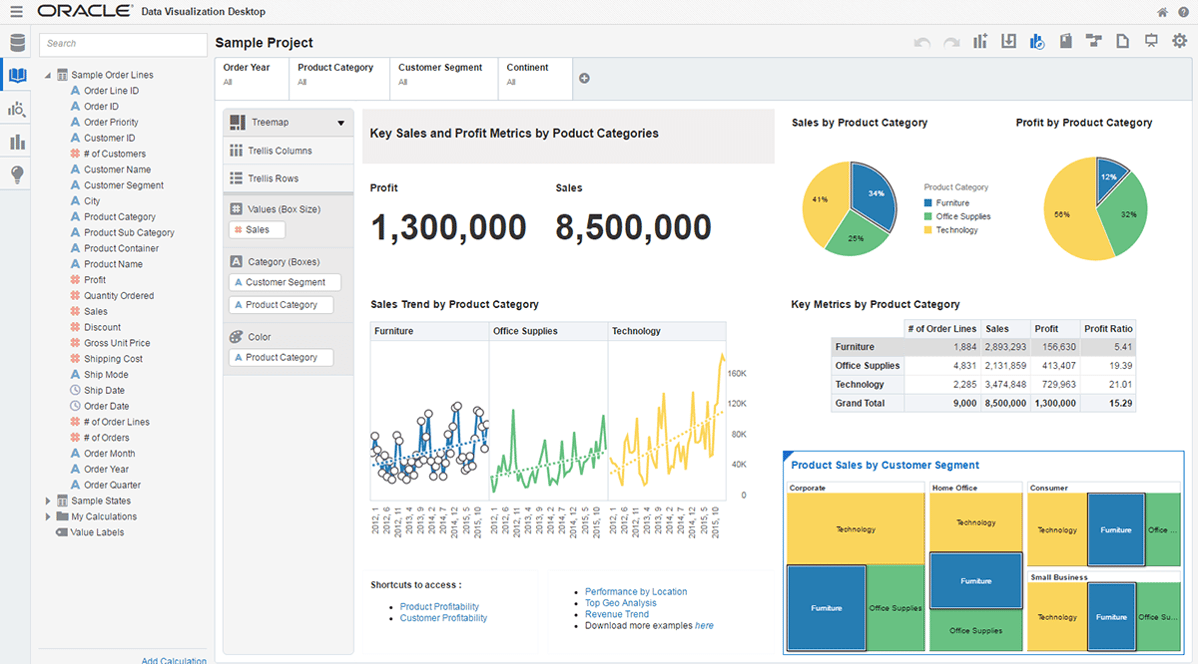- About
Getting to know us
- Services
- Managed Services
- Application Services
- Cloud Services
- Data Science
- Consulting Services
- Technology Solutions
Managed Services
Application Services
Data Science
Consulting Services
Technology Solutions
- Industries
- Resources
Resources
- Contact
- Contact us
Oracle Data Visualization Cloud Service
Contents
In recent months Oracle has extended its portfolio of data analytics solutions. Building on the availability of Data Visualization Business Intelligence Cloud Service in recent months it has released new versions:
- Data Visualization Cloud Service (DVCS) (Oct 2015)
- Data Visualization Desktop (DVD) (May 2016)
The new releases are targeted at the growing market for business users buying software and is intended for those starting out with analytics, but offering the potential to grow into Business Intelligence Cloud Service down the line.
Oracle’s research informs them that business users are demanding faster response times to data questions and seek greater self-service. DVCS and DVD provide powerful analytics accessible to everyone:
- no training or specialist IT skill required
- creates rich, visual analytics intuitively
- blends multiple data sources
- enabling sharing of insights and stories, and collaborative working
Data Visualization Cloud Service
DVCS home page displays Visual Analyzer projects currently in the current user’s folder, and provides access to key functionality via badges.
Figure 1. Oracle DVCS Home Page
Academy
Provides access to online video guides, tutorials and help pages.
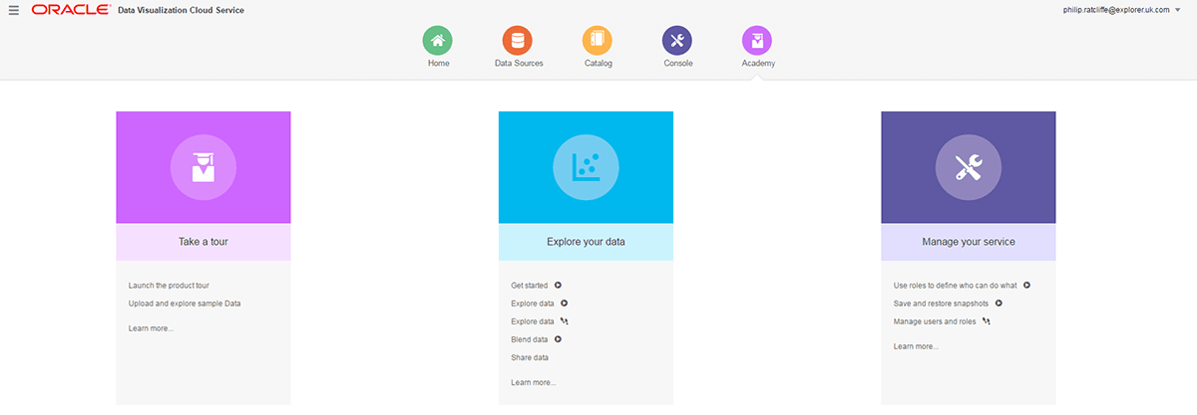
Figure 2. Oracle DVCS Academy Page
Console – for the administration of the service particularly authorisation and backup/restore
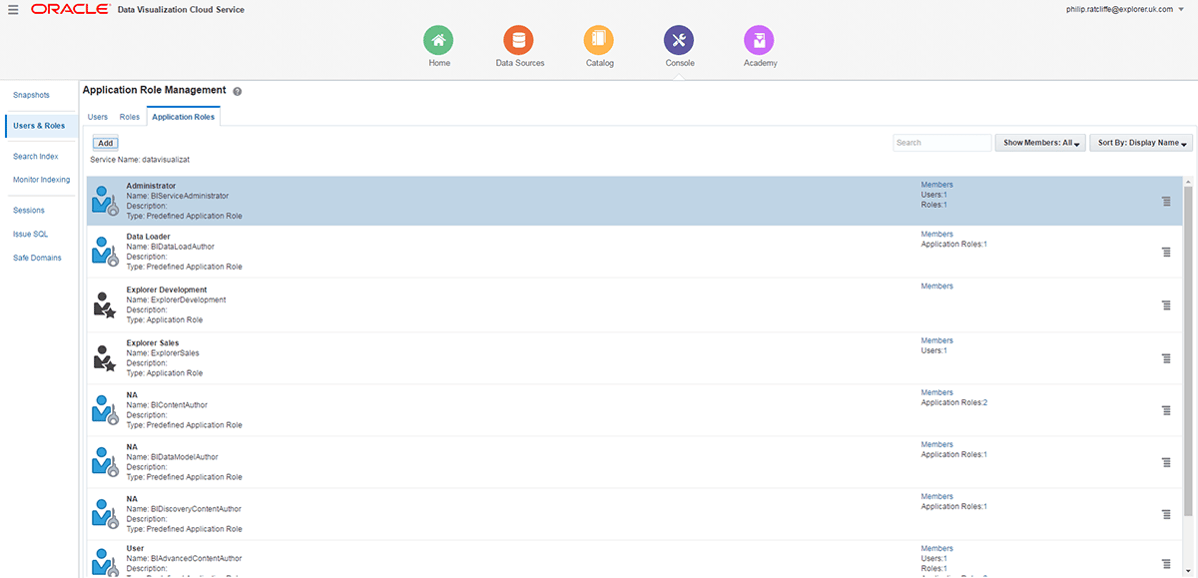
Figure 3. Oracle DVCS Console Application Role Management Page
Administration of the service is undertaken in the Console:
- Snapshot – for backing up the project Catalog or recovering from backup. A snapshot can only be taken of the entire Catalog, not individual projects.
- Users & Roles – for controlling permissions authorisation that determine what users can do and see.
- Search Index / Monitor Index – for scheduling and monitoring catalog crawls that index Catalog content so that users find the latest content when searching
- Sessions – for monitoring user activity logs including underlying SQL that is executed when users use the service
- Issue SQL – for executing SQL statements directly at the data sources. Used for testing and debugging, the SQL cannot be saved and used in VA projects
- Safe Domains – for specifying domains from which or to which users can embed content, for example to embed visualizations into BI reports.
The most important of these is arguably the Users & Roles. The foundation of authorisations within DVCS is the management of Application Roles.
Three pre-defined application roles are provided; Viewer, User, Administrator, with one inheriting characteristics of its parent
| Application Role | Description | Inherits From |
| Administrator | Delegate privileges – access to console to perform administrative tasks | User |
| User | Create visualizations, explore and load data (including with Rest API and Data Sync) | Viewer |
| Viewer | View and run visualizations | N/A |
Custom application roles can be created based on the pre-defined application roles, to suit organisational requirements. Users are then associated to these application roles.
It is via application roles that access to VA projects and data source is controlled.
Catalog – for managing folders and their content, and permissions to folders and projects
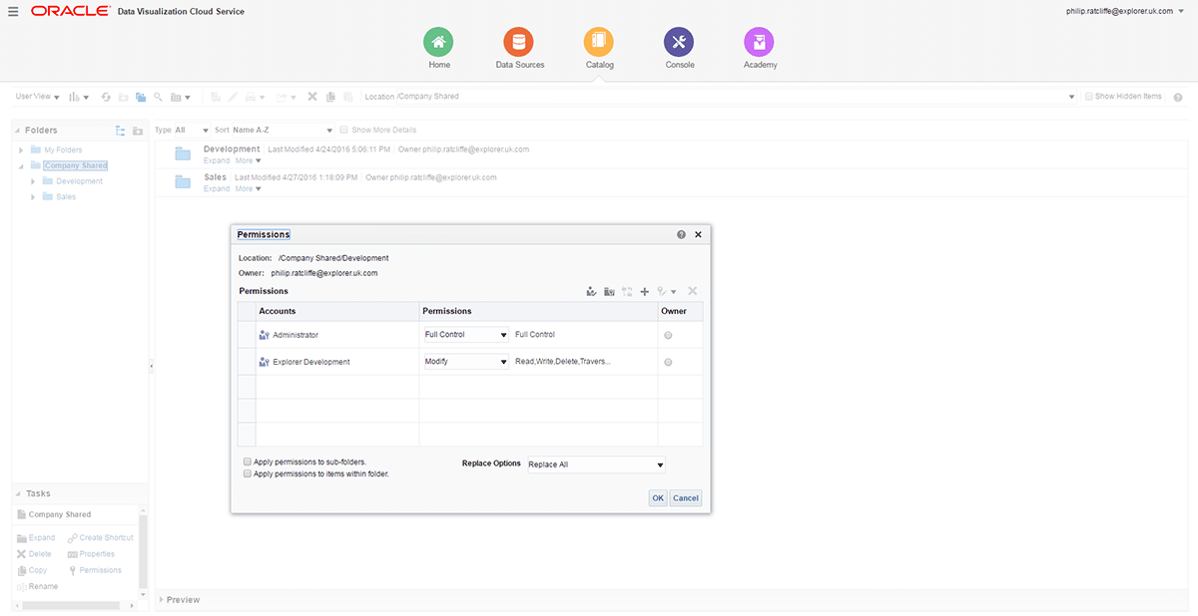
Figure 4. Oracle DVCS Catalog Page
The key purpose of the Catalog page is to set permissions on folders and projects within those folders to control which users can access those projects.
Data Sources – for managing availability and authorisation to data
It is here that data sources for use in Visual Analyzer projects can be accessed. Data sources can be established directly from:
- Excel Spreadsheet
- Data from Oracle Application Data Sources
- Connect to Oracle BI EE application
- Browse Catalogues for analyses
- Enter SQL to retrieve data required
Figure 5. Creating New Data Sources in Oracle DVCS
Alternatively, data can be transferred to DVCS using alternative methods:
Data Sync – schedule to create/refresh data from:- Data files (CSV and Microsoft Excel XLSX)
- Relational sources (Oracle, Microsoft SQL Server, DB2, Teradata, MySQL, Oracle TimesTen)
- SQL Query
- OTBI sources (Oracle Transactional Business Intelligence)
- REST API
It is also in the Data Sources page that permissions to data sources are set, determining which users/roles can access the data underpinning VA projects.
Data Visualization Desktop
There are obvious similarities between DVCS and DVD but there are differences between the current set-ups.
Figure 6. Oracle DVD Home Page
The first thing to notice is that there is no Catalog or Console for the desktop version. Because this is a single-user on-premise installation, obviously there is not the same facility for sharing data and projects, so there is no requirement for these areas of functionality.
However, DVD includes direct connectivity to databases, unlike DVCS.
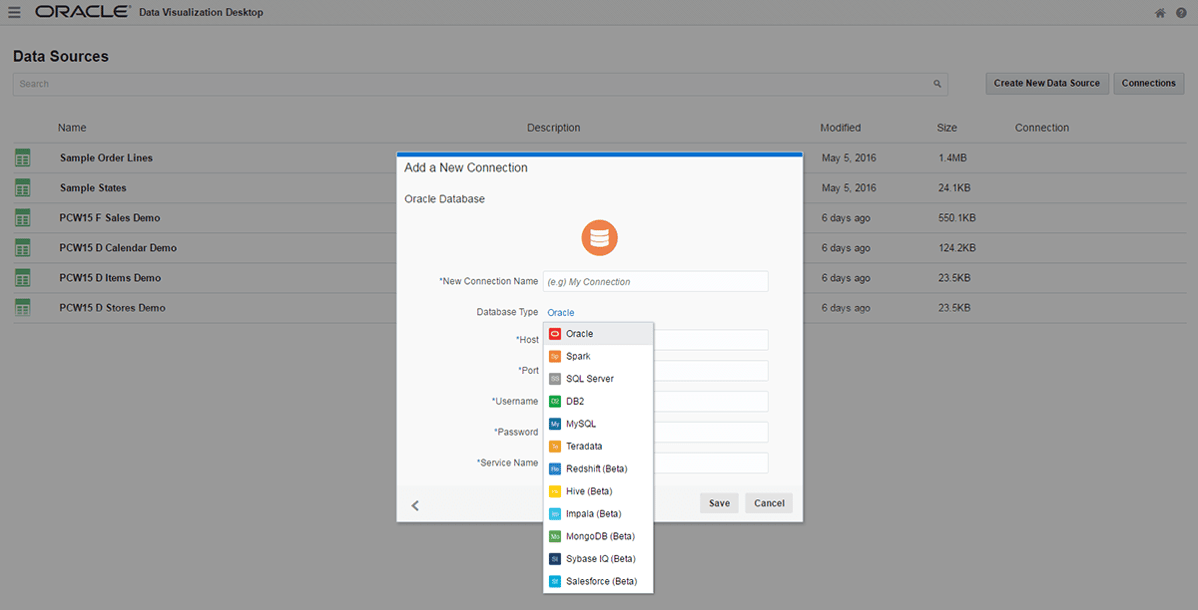
Figure 7. Creating New Database connection in Oracle DVD
Additionally, in DVD individual projects can be exported and imported, with the option to include the data sources within the import/export file.
Visual Analyzer
Figure 8. Data Visualization Visual Analyzer
The key features of Visual Analyzer are that:
- It selects the best visualization type based on the data selected by the user
- It allows multiple visualizations on a pane and highlights related data between the visualizations
- Users can create complex calculation or filters based on expressions
- It blends data sources together by automatically inferring connections between the data sets
- Users can take snapshots of visualizations (insights) to build stories that can be presented in the Story Navigator
Additionally, by using the Stage facility, users can edit the data sources, not values but structure or format.
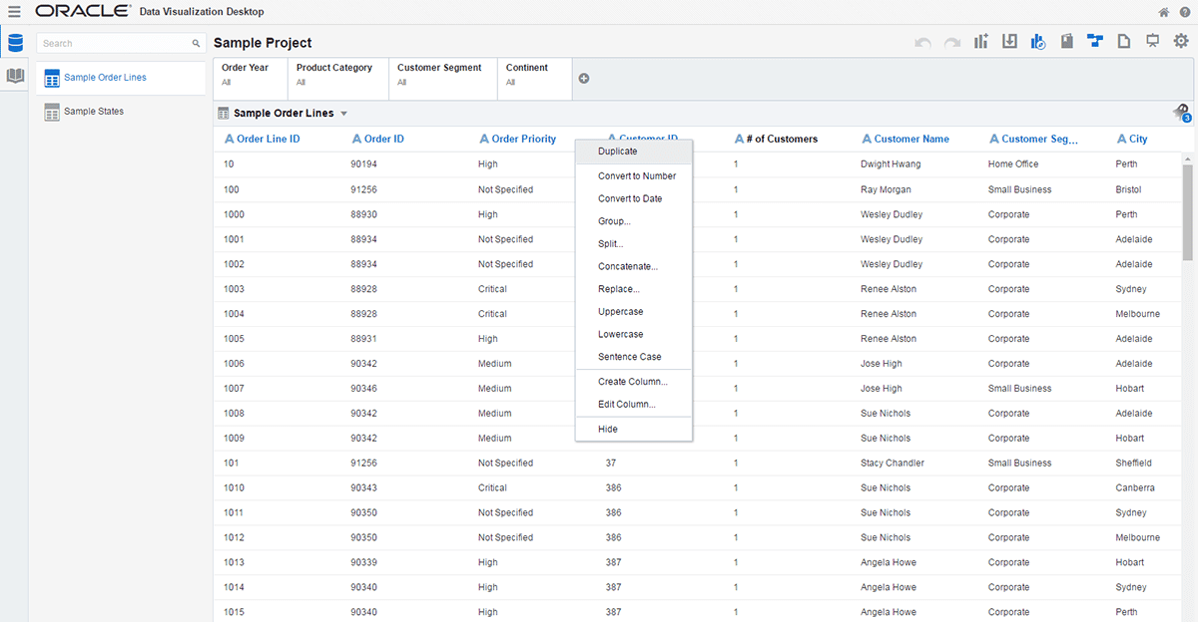
Figure 9. Visual Analyzer Stage for editing data source
VA within DVD and DVCS is broadly similar, although there is some additional visualization types in DVD, including Image, which allows uploading of images or creating URL links to reference externally hosted images.
Additionally DVD offers Advanced Analytics, which includes the ability to highlight outliers or overlay trend lines.
Figure 10. DVD Advanced Analytics
Competition
Oracle believe that they have looked at competitor products, such as QlikView and Tableau, and improved upon them by enabling:
- faster development (fewer clicks)
- improved filtering
- single pane dashboard creation
- superior mobile experience
Also, Oracle hope to introduce businesses to DVCS or DVD, in the knowledge that Oracle’s portfolio can scale with organisations’ needs and ambitions. Organisations will be able to grow into other products in the portfolio e.g. BICS (includes Data Visualization) or OBI 12c & Data Visualization
Trial Data Visualization
Both DVCS and DVD are available to use to trial / evaluate:
- DVD non-production version available from OTN: Download DVD now from OTN
- DVCS available for 30 day free trial: Data Visualization Cloud Service (DVCS) and click ‘Try It’
Other Links
- Oracle Data Visualization Desktop community
- Oracle Help Center: Oracle Data Visualization Desktop – Get Started
- Oracle Help Center: Oracle Data Visualization Cloud Service – Get Started
Licensing
Oracle are currently offering a perpetual single user license for Data Visualization Desktop.
Data Visualization Cloud Service is currently licensed based on on an operational cost per month per user, with a minimum of five users.
However, DVD is packaged at no extra cost with DVCS (or BICS), so customers who subscribe to it, currently can receive a matching number of DVD licenses at no extra charge.
Conclusion
Oracle Data Visualization offers some attractive features to help users understand their data and share appealing visuals.
Currently, DVD and ODVCS offer slightly different functionality to each other (e.g. connectivity, advanced analytics). However, Oracle intend that from later this year all versions of DV will be synchronised, which will mean DVCS users will be able to take advantage of the additional functionality available in DVD.
In the coming weeks and months I will provide updates as I delve a little deeper into specific areas of functionality such as:
- Controlling access to projects, data sources and functionality
- Connecting to, loading and editing data sources
- Getting the most out of Visual Analyzer
Author: Philip Ratcliffe
Job Title: Oracle APEX Development Consultant
Bio: Philip is a Development Consultant at DSP-Explorer. Building on considerable experience in development including using Oracle PL/SQL and supporting Oracle EBS, Philip is employing APEX to provide quality, bespoke software solutions to a range of organisations.

.png?width=250&name=stonewater-logo%20(1).png)

